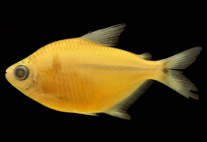Abstract
From the examination of extensive comparative material currently identified as M. jamesi we verified that there are, at least, three new species under this name. These, along with M. jamesi and M. justae, form what we herein called the M. jamesi species complex, by sharing the following group of characters: a short maxilla, with its distal margin not exceeding anterior third of the second infraorbital; first through third teeth of the inner row of premaxilla and first and second dentary teeth with cusps arranged in a pronounced arch, humeral spot positioned between the fourth and seventh scales of the lateral line and extending up to four scale rows above the lateral line and one scale row below the lateral line, and a vertically oval to round spot at the base of the caudal fin rays. Moenkhausia ischyognatha sp. n., from Rio Xingu basin, differs from the other species of the complex by its lower head depth. Moenkhausia alesis sp. n., from the river system Tocantins-Araguaia, differs from M. jamesi, M. ischyognatha, and M. sthenosthoma by the number of scale rows above the lateral line. Moenkhausia sthenosthoma sp. n., from the Rio Madeira basin, differs from M. jamesi by the number of scale rows between the lateral line and the midventral scale series. Moenkhausia justae can be diagnosed from the other species of the complex by having a tri to pentacuspidate tooth on the maxilla.

